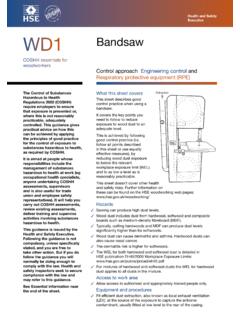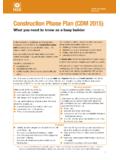Transcription of The 6 Most Common PID Configuration Errors: How to Find ...
1 Real-Time Performance supervision by ExperTune. Phone: (262) 369-7711 The 6 Most Common PID Configuration Errors: How to Find and Fix Them 2008 ExperTune, Inc. George Buckbee, ExperTune, Inc. Real-Time Performance supervision by ExperTune. Phone: (262) 369-7711 The 6 Most Common PID Configuration Errors: How to Find and Fix Them George Buckbee, , ExperTune Inc. 2008 ExperTune Inc Summary The PID Control Loop is one of the fundamental workhorses of the process industries. Day in and day out, millions of PID loops strive to keep processes safe, stable, and profitable. But there is a secret, known only to control engineers and of these control loops are not properly the consequences could be devastating. This paper identifies the most Common PID Configuration issues, and provides techniques to help plant-based personnel to find and fix these issues.
2 Overview How Control Systems Deliver Results The control system acts as the nervous system for the plant. It provides sensing, analysis, and control of the physical process. The control system sits directly between the operator and the all of the operator s information comes from the control system, and all of the operators commands are carried out by the control system. When a control system is at peak performance, process variability is reduced, efficiency is maximized, energy costs are minimized, and production rates can be increased. The Role of the PID Loop Each individual PID control loop is responsible to maintain a single process variable at its setpoint. The control loop consists of an instrument, a controller, and some type of manipulated variable, usually a control valve.
3 The PID loop must respond quickly and appropriately to any process upsets or load disturbances, as well as to operator setpoint changes. The loop may also coordinate its actions with other control loops, as in a cascade, ratio, or feedforward control scheme. Ultimately, the PID loop s role is to reduce process variability. Real-Time Performance supervision by ExperTune. Phone: (262) 369-7711 PID Loop Performance Surprisingly, as many as 75% of control loops actually increase variability! Many control loops simply do not do their job. Setpoints are not followed, valves swing around, creating oscillations, and many loops are disabled by the operator: placed in MANUAL mode. Poor performance happens in large part due to control loop Configuration issues.
4 Studies of control loops in the process industries give some insight into the root cause of these issues. For example: 30% of DCS Control Loops Improperly Configured 85% of Control Loops Have Sub-Optimal Tuning 15% of Control Valves are Improperly Sized In the sections below, this white paper will show you how to identify and resolve specific issues at the root cause of poor controller performance. PID Controller Configuration Consider the Whole Loop When you think about a control loop, it is critical to think about the whole loop. This includes: The instrument, its parameter settings, mounting, and location in the process Wiring, I/O, and DCS/PLC hardware and operating system The PID controller itself, and all its Configuration settings The valve, actuator, and positioner.
5 Their location and installation in the process. In this white paper, we will focus on the Configuration issues. But you should be aware that mechanical issues with the instrument and the valve could play a major role in the performance of the controller. Remember: No amount of tuning can fix a broken valve! The Most Common Issues The most Common Configuration issues include: 1. Choosing the Wrong Algorithm 2. Improper Tuning 3. Over- or Under- Filtering 4. Improper Configuration of Control Strategy 5. Spanning and Scaling 6. Scan-related Issues Real-Time Performance supervision by ExperTune. Phone: (262) 369-7711 In the sections below, this paper will address each of these Common Configuration issues. You will learn how to identify these issues in your plant, and how to make corrections to improve process performance.
6 Choosing the Algorithm The Problem & Its Effects The choice of control algorithm is crucial to good process control. Over the years, many DCS suppliers have included a wide variety of specialized variations on the PID algorithm. This gives the engineer many great options for those special-case loops. However, many of these special-case algorithms are often applied to the wrong situation. The effects are widespread. The wrong algorithm choice can lead to: Inability to track setpoint Creating sustained oscillations Excessive wear-and tear on the control valve Excessive process movement in response to setpoint changes At the business level, these problems can have a direct effect on quality, and indirect effects on energy costs and production rate. Figure 1. A Report Showing Controller Algorithm Types Real-Time Performance supervision by ExperTune.
7 Phone: (262) 369-7711 Identifying PID Loops with Algorithm Problems A few general rules can be applied to help find loops with the wrong algorithm. You can start by generating a list of all the control loops in your plant, sorted by controller algorithm. Figure 1 shows such a list, generated by ExperTune s PlantTriage. The following algorithm choices should be avoided, except in certain special cases. Algorithms to Avoid Algorithm Choice Why to Avoid Special Cases Derivative on Error Causes derivative kick on setpoint changes, excessive wear on valve. Especially damaging when used on the inner loop of a cascade system. Use Derivative on PV instead. Rarely. PID-GAP Does not allow PV to track the Setpoint closely. Often leads to a sustained oscillation, or PV offset from setpoint.
8 If minimizing control valve action is more important than good control. Surge tanks. Integral-Only Does not respond quickly to upsets or setpoint changes. Slow, smooth transitions are required. There are as many variations on control algorithm as there are control vendors. You should use caution when applying anything other than a plain vanilla PID controller, because there could be unintended Fixing the Problem First, make sure that the algorithm was not selected for one of the special case reasons. Resolving algorithm issues usually requires some form of change management approval. Here are a few tips to make it easier to correct the algorithms: To simplify the work, try addressing these issues in bulk , rather than individually.
9 Always make sure that you have a complete control system backup before you start making these changes. Make the changes during a shut down if possible. If changes are made while running, hold the control output at a steady value while swapping algorithms. Closely coordinate with operations. Make sure that operators are prepared to report any strange behavior right away. Real-Time Performance supervision by ExperTune. Phone: (262) 369-7711 Improper Tuning The Problem & Its Effects Typically, 30% of loops have tuning that makes no sense whatsoever, and 85% of loops have sub-optimal tuning. We all know why this plants do not have a standard method, practices, training, or tools for loop tuning. Many plants still tune by feel . This leads to inconsistent and often terrible tuning results.
10 It is not surprising that you may find as many as 30% of control loops running in manual! The effects of poor tuning are: Sluggish loops do not respond to upsets, causing disturbances to propagate Overly-aggressive loops oscillate, creating new disturbances Operators put the loops in manual. The loops are unable to respond, increasing the risk of safety, environmental, and quality incidents. Identifying PID Loops with Tuning Problems ExperTune s PlantTriage software automatically finds control loops with tuning problems. Using Active Model Capture Technology , the software automatically finds process models, and compares the current tuning against the ideal. The user can receive a list of loops that require tuning, delivered by email. Fixing the Problem Good controller tuning requires training, tools, and techniques.












